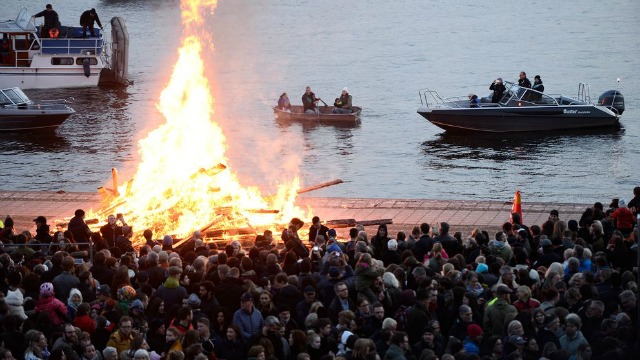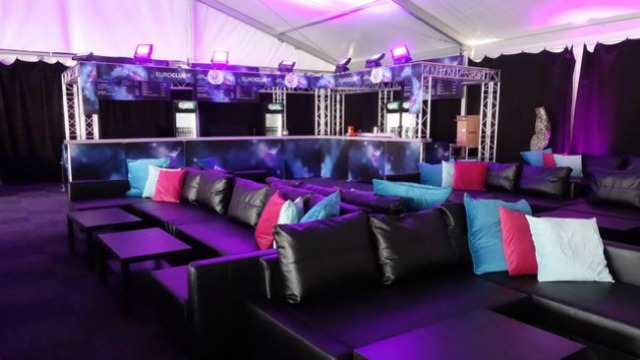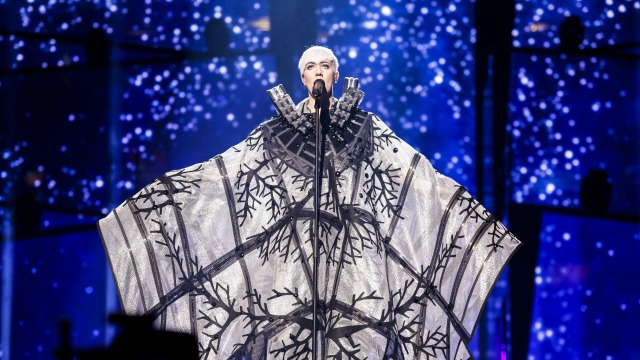Stockholm has a special place in my heart. It was here in 2008 that I made my first Eurovision-related pilgrimage, to witness Charlotte Perrelli’s triumph at Sweden’s Melodifestivalen final. As soon as I gazed upon that remarkable visage, fist aloft in victorious ‘slutpose’ as lasers streaked across the arena, I knew in my heart that I was a lifer.
Alas, wider European televoters proved immune to Perrelli’s cosmic charms, and it would be another eight years before Eurovision proper finally returned to the Swedish capital, bringing with it a decidedly non-Nordic heatwave that bathes the city’s glorious seafronts and harbours in sunlight. It’s good to be back.
Our arrival in Stockholm on Saturday 30th April coincides with one of Sweden’s more eccentric public holidays – Valborg, the official celebration of the arrival of summer. Nowhere is Sweden’s unique combination of hyper-efficiency and intensely relaxed attitude towards public health and safety more adequately expressed than on this day, in which the population of Stockholm spend the entire day getting drunk while handing out burning torches to small children, followed by the construction of an enormous bonfire in broad daylight, which they stare at for approximately ten minutes before abruptly packing up and going home en masse.

Sweden welcomes the summer the only way they know how – by getting drunk and lighting a giant bonfire in broad daylight.
Just over the road from this amiable recreation of the final moments of The Wicker Man, we find this year’s Euroclub, this year a temporary building specially constructed on Gamla Stan’s picturesque harbour. Quite what the Stockholm population make of this prefab monstrosity being unceremoniously dumped into the middle of their formerly pedestrianised waterfront is unclear, but they’re not a people given to public grumbling.
In a very Scandinavian display of democracy, the Euroclub this year is being combined with the fan cafe, meaning press, delegates, OGAE members and – during daytime hours – even the general public can quite literally come together in an extensive room complex featuring multiple bars, dance floors and IKEA-branded furnishings as far as the eye can see. On Sunday afternoon I join a guided preview tour run by Insight’s own Ben Robertson, who has played a key role in facilitating the relationship between Stockholm city council and the local fan community. Having experienced Swedish nightlife before, I and the rest of the assembled journalists make an immediate beeline for the nearest bar to examine the price list and calculate the level of debt we’ll be working off for the remainder of 2016.

Uniting the press, the artists and accredited fans together under one roof, this year’s Euroclub exemplifies the ‘Come Together’ ethos of the 2016 Contest.
Photo: SVT.se
After a weekend of basking in the surprise Swedish sunshine, by the time Monday rolls around it’s time to assume our roles as full time mole people for the remainder of the fortnight, as we take our places in the windowless converted hockey arena that will be acting as this year’s press centre. Swedish hospitality is in full effect, with traditional Fika fare (coffee and cake) served up in seemingly inexhaustible volume. Unfortunately, Swedish scale of economy is also in full effect, with the restaurant menu charging an eye-watering 90kr for a basic salad, with “optional protein” a steal at an additional 35kr. Packed lunches are likely to feature heavily in my diet for the next two weeks.
Located at the bottom of a genuinely terrifying flight of stairs, the main hall of the press centre is a vast open-plan hall with screens set up on every available wall space to stream the rehearsals from the adjacent arena. Technical issues marr the first half of the day, with the sound feed for Greece, Moldova and Hungary intermittent at best. Fortunately these niggles are largely ironed out by the time the really competitive entries take to the stage. Armenia and Netherlands hit the ground running with assured, confident performances from their first rehearsals, while Croatia is vocally impressive but raises eyebrows with a bizarre shapeless kimono that marks her out as the potential Trijntje Oosterhuis of this year’s contest.

Croatia’s Nina Kraljić raised eyebrows with a voluminous kimono-style dress in her first rehearsals.
Photo: Eurovision.tv
Pre-contest favourites Russia can clearly taste the win already, throwing everything against the wall in an intermittently impressive but messy and overly frantic stage concept that ends with Sergey looking wild-eyed and vaguely maniacal, striking a classic victory pose while red faced and drenched in sweat. The effect is presumably intended to be triumphal, but it’s currently landing on terrifying.
The other important function of the press centre is to host the press conferences with the artists immediately following their rehearsals, where the questions seldom venture beyond polite fluff, but the personalities of the performers get an opportunity to come through. Lidia from Moldova reveals a surprising past life as a thirteen year-old Edith Piaf impersonator, while Serhat from San Marino wins major brownie points by revealing he attended the 2000 contest at Stockholm as a fan, and describing the retooled disco mix of his entry as a tribute to the music of Gloria Gaynor, Donna Summer and Shirley Bassey.
Sergey predictably draw the biggest crowd, with a high volume of Russian TV and radio press speaking to his celebrity status and the high expectations surrounding his entry. He seems a little tentative, perhaps due to an imperfect first rehearsal, but it soon becomes evident that there’s a great deal of pressure on him to succeed. He diplomatically bats away several questions that frame his victory as a mere formality at this point, and offers sincere praise for his fellow competitors. Harder questions about booing in the arena and Russia’s human rights record will likely come with the arrival of headline-hungry tabloid press in the second week. For now, artists and press alike are enjoying a smooth, drama-free beginning to what promises to be a long and eventful two weeks…









